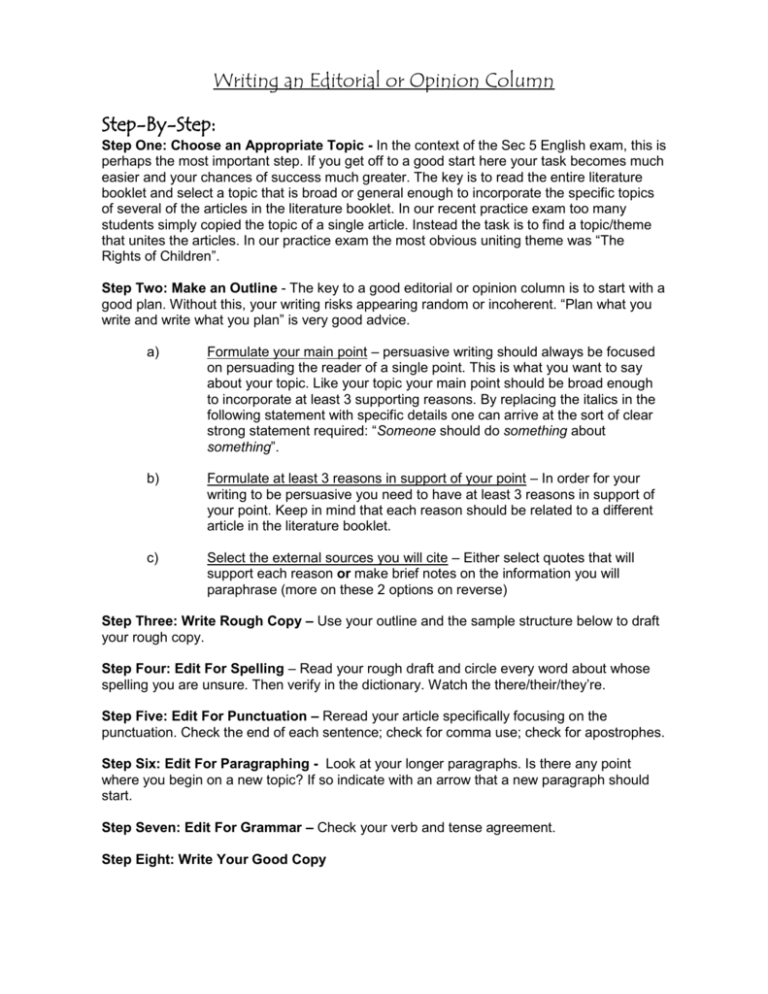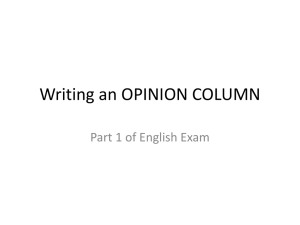Writing an Editorial or Opinion Column.doc
advertisement

Writing an Editorial or Opinion Column Step-By-Step: Step One: Choose an Appropriate Topic - In the context of the Sec 5 English exam, this is perhaps the most important step. If you get off to a good start here your task becomes much easier and your chances of success much greater. The key is to read the entire literature booklet and select a topic that is broad or general enough to incorporate the specific topics of several of the articles in the literature booklet. In our recent practice exam too many students simply copied the topic of a single article. Instead the task is to find a topic/theme that unites the articles. In our practice exam the most obvious uniting theme was “The Rights of Children”. Step Two: Make an Outline - The key to a good editorial or opinion column is to start with a good plan. Without this, your writing risks appearing random or incoherent. “Plan what you write and write what you plan” is very good advice. a) Formulate your main point – persuasive writing should always be focused on persuading the reader of a single point. This is what you want to say about your topic. Like your topic your main point should be broad enough to incorporate at least 3 supporting reasons. By replacing the italics in the following statement with specific details one can arrive at the sort of clear strong statement required: “Someone should do something about something”. b) Formulate at least 3 reasons in support of your point – In order for your writing to be persuasive you need to have at least 3 reasons in support of your point. Keep in mind that each reason should be related to a different article in the literature booklet. c) Select the external sources you will cite – Either select quotes that will support each reason or make brief notes on the information you will paraphrase (more on these 2 options on reverse) Step Three: Write Rough Copy – Use your outline and the sample structure below to draft your rough copy. Step Four: Edit For Spelling – Read your rough draft and circle every word about whose spelling you are unsure. Then verify in the dictionary. Watch the there/their/they’re. Step Five: Edit For Punctuation – Reread your article specifically focusing on the punctuation. Check the end of each sentence; check for comma use; check for apostrophes. Step Six: Edit For Paragraphing - Look at your longer paragraphs. Is there any point where you begin on a new topic? If so indicate with an arrow that a new paragraph should start. Step Seven: Edit For Grammar – Check your verb and tense agreement. Step Eight: Write Your Good Copy Sample Structure Editorial 1) Headline – Try to use some alliteration 2) Hook/lead – A shocking stat or a rhetorical question works well. 3) Objective/unbiased description of your topic – paraphrasing external source can be useful here. 4) Present an opposing viewpoint – Take your main point and imagine why someone might disagree. For example, “Some have argued that children’s rights should not be legally protected due to their need for adult protection. Adults need to control children form time to time for their own protection. Technically this may involve infringing their rights” 5) Clearly present your main point 6) Present your first supporting reason – This involves: POINT – state the reason; PROOF – paraphrase or quote an external source; ANALYSIS – comment on the proof presented. 7) Present your second supporting reason – Again POINT, PROOF, ANALYSIS 8) Present your third supporting reason – POINT, PROOF, ANALYSIS 9) Conclude by creatively restating your main point 10) Finish with a statement linking to your hook/lead Opinion Column 1) Headline - Try to use some alliteration 2) By-line – your name 3) Hook/lead – A shocking stat or a rhetorical question works well. 4) Creatively introduce your topic 5) Clearly present your main point 6) Present your first supporting reason – This involves: POINT – state the reason; PROOF – paraphrase or quote an external source; ANALYSIS – comment on the proof presented. 7) Present your second supporting reason – Again POINT, PROOF, ANALYSIS 8) Present your third supporting reason – POINT, PROOF, ANALYSIS 9) Conclude by creatively restating your main point 10) Finish with a statement linking to your hook/lead Paraphrasing vs. Quotes In either case, because this is not an essay or a research paper, you do not include a source list or bibliography. Instead you acknowledge the source write in the text. For example: “According to the article Saving the Child Soldiers by Bill Smith…” or Paraphrasing should be used when summarizing or describing the central aspect of a text. For example: “In the short story Harrison Bergeron, Kurt Vonnegut Jr. explores the themes of conformity and rebellion…” Paraphrasing is more common in editorial and opinion column writing. Quotes should only be used when there is something specific about the author’s words you need to reveal to your reader. This could be a precise statistic or a very specific phrase. For example: One of the most enjoyable aspects of Vonnegut’s writing is the creativity and humour of his figurative language. For example in describing the effects of ‘ethical birth control pills’ in Welcome to the Monkey House, Vonnegut writes, “Most men said their bottom halves felt like cold iron or balsa-wood. Most women said their bottom halves felt like wet cotton or stale ginger ale.”






